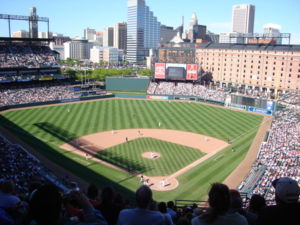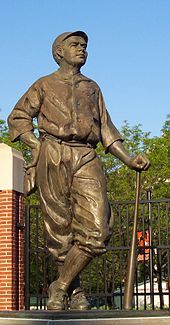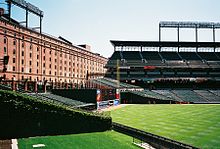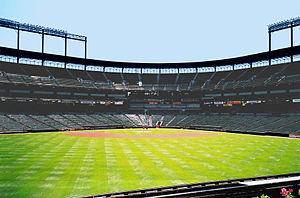- Oriole Park at Camden Yards
-
Oriole Park at Camden Yards Camden Yards, The Yard, Birdland, and "The House That Cal Built"

Location 333 West Camden Street
Baltimore, Maryland 21201Coordinates 39°17′2″N 76°37′18″W / 39.28389°N 76.62167°WCoordinates: 39°17′2″N 76°37′18″W / 39.28389°N 76.62167°W Broke ground June 28, 1989 Opened April 6, 1992 Owner Maryland Stadium Authority Surface Kentucky Blue Grass Construction cost $110 million
($172 million in 2011 dollars[1])Architect Populous (Formerly HOK Sport) Project Manager Barton Malow / Sverdrup[2] Structural engineer Bliss and Nyitray, Inc. General Contractor Danobe Construction[2] Capacity 48,876[3] (1992-2010) with standing room at least 49,137 (97)
45,480 (2011-)[4] with standing room at least 46,593Field dimensions Left Field - 333ft (101.5 m)
Left-Center - 364ft (110.9 m)
Left-Center (deep) - 412ft (125 m)
Center Field - 400ft (121.9 m) (Not posted)
Right-Center - 373ft (113.7 m)
Right Field - 318ft (96.9 m)Tenants Baltimore Orioles (MLB) (1992–present) Oriole Park at Camden Yards is a Major League Baseball ballpark located in Baltimore, Maryland. Home field of the Baltimore Orioles, it is the first of the "retro" major league ballparks constructed during the 1990s and early 2000s, and remains one of the most highly praised.[5] The park was completed in 1992 to replace Memorial Stadium. It is situated in downtown Baltimore a few blocks west of the Inner Harbor in the Camden Yards Sports Complex.
Historically, Oriole Park at Camden Yards is one of several venues that have carried the "Oriole Park" name for various Baltimore franchises over the years. The park is typically known simply as "Camden Yards."
Contents
History
Construction
Prior to Oriole Park at Camden Yards, the predominant design trend of big league ballparks was the symmetrical "multi-purpose stadium". Camden Yards was the first Major League downtown "retro" ballpark. The master plan was designed by international design firm, RTKL. The stadium design was completed by the architectural firm HOK Sport (now Populous), which had pioneered retro ballparks on the minor league level four years earlier with Coca-Cola Field in Buffalo, New York.
Construction began in 1989, and lasted 33 months. Former Orioles owner Eli Jacobs favored naming the new field Oriole Park, while then-Maryland Governor William Donald Schaefer favored Camden Yards. After considerable debate a compromise was reached to use both names.[6]
1992–present
The ballpark opened on April 6, 1992 with the Orioles hosting the Cleveland Indians. The great success of Camden Yards which followed sparked a trend in the construction of more traditional, fan-friendly ballparks in downtown locations across the U.S. Camden Yards hosted the 1993 MLB All-Star Game. On June 18, 1994, 43 fans were injured in an escalator accident; one of the stadium's multiple-story escalators, overcrowded with fans heading to their upper-deck seats, jerked backward, throwing passengers to the bottom landing. On September 6, 1995, Camden Yards witnessed Cal Ripken, Jr.'s record-setting 2,131st consecutive game. Exactly one year later, Eddie Murray blasted his 500th home run there.
Two orange seats stand out from the park's dark green plastic chairs. One, located at Section 96, Row 7, Seat 23 in the right-center field bleachers (officially known as the Eutaw Street Reserve sections), commemorates the spot where Murray's 500th home run landed. The other, Section 86, Row FF, Seat 10 in the left field bleachers, was the landing spot for Ripken's 278th home run as a shortstop, breaking Chicago Cubs legend Ernie Banks' record for the position. That home run was hit on July 15, 1993. Ripken finished his career with 345 home runs as a shortstop and 431 overall.
Attendance
Between 1992–2000, the Orioles averaged more than 40,000 spectators per game, with a total attendance of 3.71 million persons in the 1997 season.[7] Since then, attendance has declined to 1.9 million in the 2009 season.[8] The current single game highest attendance record at Camden Yards is 49,828, set on July 10, 2005 against the Boston Red Sox. On April 12, 2010, the low-attendance mark was set, when just 9,129 fans watched the Orioles play the Tampa Bay Rays.
On August 19, 2008, the stadium hosted its 50 millionth fan, a milestone reached in just seventeen seasons, the fastest park in baseball history to reach such a figure. Since opening in 1992, Oriole Park has hosted the third-most number of fans in Major League Baseball, exceeded only by Dodger Stadium and the first Yankee Stadium.[9]
Notable games
- September 6, 1995: Cal Ripken, Jr. broke Lou Gehrig's record of 2,130 consecutive games played, and hit a home run. Attendees of the game included President Bill Clinton and Vice President Al Gore, as well as Cal Ripken, Sr..
- September 6, 1996: Eddie Murray hit his 500th career home run exactly one year after Cal Ripken, Jr. broke Lou Gehrig's consecutive game streak.
- October 15, 1997: The Cleveland Indians win Game 6 of the 1997 ALCS 1-0 in 11 innings to win the series 4-2 and advance to the 1997 World Series.
- April 4, 2001: Hideo Nomo pitched the first no-hitter in the history of Camden Yards, walking three and striking out eleven.
- October 4, 2001: Tim Raines, Sr. played left field and Tim Raines, Jr. played center field, in the 5-4 loss to the Boston Red Sox becoming only the second father-son duo to play in the same game. Ken Griffey, Sr. and Ken Griffey, Jr. were the only other father-son duo to do so (with the Seattle Mariners, on August 31, 1990).
- October 6, 2001: Cal Ripken, Jr.'s final MLB game. Former President Bill Clinton and MLB Commissioner Bud Selig were in attendance.
- August 22, 2007: The Texas Rangers beat the Orioles 30–3 in game one of a doubleheader, the highest scoring game in 110 years.
- June 30, 2009: The Orioles rallied to score 10 runs against the Red Sox after facing a 10–1 deficit in the 7th inning, breaking the franchise record for the largest comeback, and the Major League Baseball record for the largest comeback by a last place team over a first place team.
Design and features
 Susan Luery's 1996 statue of Babe Ruth, Babe's Dream
Susan Luery's 1996 statue of Babe Ruth, Babe's Dream
Camden Yards was built on land that once served as the rail yard for the Baltimore and Ohio Railroad's Camden Station. The view from much of the park is dominated by the former B&O Warehouse behind the right-field wall. Many seats in the stadium have a good view of the downtown Baltimore skyline.
The bullpen area was designed after many write-in designs were submitted by the public. Its unique two-tiered design was a first in major league parks.
On the street there is a statue of Babe Ruth entitled, Babe's Dream, created in 1996 by sculptor Susan Luery.[10] In the same courtyard, you'll find sculptures indicating the retired jersey numbers of the Baltimore Orioles.
The scoreboard in center field advertises The Baltimore Sun at the top. The "H" in "The Sun" will flash to show a scoring decision of a hit, and the "E" will flash to show an error.
The stadium is the first major league park to have an outfield wall made up entirely of straight wall segments since Ebbets Field. The playing field is 16 feet below street level. The stadium contains 4,631 club seats and 72 luxury suites.
Seating Capacity
- 48,041 (1992-1996)
- 48,079 (1997-2000)
- 48,190 (2001-2004)
- 48,290 (2005-2010)
- 45,480 (2011-present)
Renovations
After the 2008 season, a new HD video display and scoreboard were installed above the right field bleachers. A new, high fidelity, sound reinforcement system was added around the ballpark in 2009. The Orioles made numerous improvements to their home ballpark and to their spring training facility, Ed Smith Stadium, before the start of the 2011 season. All seats in the lower seating bowl were replaced and drink rails were added in the club level. Several skyboxes were also eliminated and refurbished to make room for more party suites and casual luxury boxes. The renovation reduced Oriole Park's capacity from 48,876 to 45,363, making it more compatible with newer ballparks.
B&O Warehouse
 Right field and the former B&O warehouse
Right field and the former B&O warehouse
The stadium planners incorporated the warehouse into the architecture of the ballpark experience rather than demolish or truncate it. The floors of the warehouse contain offices, service spaces, and a private club. The warehouse has been hit on the fly only once, by Ken Griffey, Jr. during the Home Run Derby of the 1993 MLB All-Star Game.
Eutaw Street
Eutaw Street, between the stadium and the warehouse, is closed to vehicular traffic. Along this street, spectators can get a view of the game or visit the many shops and restaurants that line the thoroughfare, including former Oriole star Boog Powell's outdoor barbecue stand. On game days, pedestrians must have a ticket in order to walk on the part of Eutaw Street adjacent to the stadium; however, on non-game days the street is open to all, while access to the stadium is gated. Sections 90–98, called Eutaw Street Reserve, are located not in the stadium, but adjacent to Eutaw Street, with the seats descending toward the outfield below. If a game sells out, fans may purchase reduced-price "Standing-room only" tickets, which entitle them to enter Eutaw Street and watch the game from two designated standing areas.
Many home run balls have landed on Eutaw Street, and the Orioles organization has marked the spots with small baseball-shaped bronze plaques embedded in the street, though it sometimes takes up to a year for each homer to get a plaque. The first home run to reach Eutaw Street was hit by Mickey Tettleton of the Detroit Tigers on April 20, 1992.[11] The most recent home run to land on Eutaw Street was on August 26, 2011 when Nick Swisher of the New York Yankees hit a two-run home run over the right field stands versus the Orioles.
Blocked skyline views
In 2007–2008 construction started (building completed 2009) on two large buildings beyond the stadium's outfield walls — a 757–room Hilton Baltimore hotel north of the stadium occupying a two-city block area and a high-rise apartment building —has blocked views of the city's skyline from most sections of the grandstand. The Baltimore Sun said on April 21, 2008, "There's just a glimpse of the Bromo Seltzer Tower's crenellated top just to the right of the new Hilton Baltimore Convention Center hotel ... something's drastically different at Oriole Park this year ... the sweeping view of downtown Baltimore that fans have enjoyed for the past 16 seasons has changed considerably..."[12] Sportswriter Peter Schmuck complained, "the big, antiseptic convention hotel ... looms over Camden Yards ... [and] has blocked out the best part of the Baltimore skyline".[13] A Washington Post columnist called it a "cruel cubist joke on a previously perfect ballpark", although others said they were pleased with new construction downtown as indicative of urban revitalization.[12]
Access and transportation
On the far side of the B&O Warehouse is the present Camden Yards station, served by both the Baltimore Light Rail and MARC commuter rail. The latter rail line provides direct service to Washington, D.C., and the former to BWI Airport. The Light Rail service began around the time the stadium opened.
The stadium is located in downtown Baltimore, near the Inner Harbor. The ballpark, along with the adjacent M&T Bank Stadium, home of the Baltimore Ravens of the National Football League, make up the Camden Yards Sports Complex, though Camden Yards generally refers to only the baseball stadium. The football stadium was not built until 1998. Camden Yards is just a short walk from Babe Ruth's birthplace, which is now a museum. According to some sources, Ruth's father once owned a pub located in what is now center field of the stadium.(http://www.ballparks.com/baseball/index.htm, on the Oriole Park page)
In May 2005, a new sports museum, Sports Legends at Camden Yards, opened in Camden Station.
Ballparks influenced by Camden Yards
Since its opening day in 1992, Camden Yards was a success and fan favorite. Attendance jumped from an average of 25,722 over the last ten years of Memorial Stadium's tenure to an average of 43,490 over the first ten years of Camden Yards' existence.[14] Due to its success, many other cities built traditional-feeling asymmetrical ballparks with modern amenities (such as skyboxes) in a downtown setting. Many of these stadiums, like Camden Yards, incorporate "retro" features in the stadium exteriors as well as interiors; these parks have been dubbed "retro-classic" parks. Other parks, known as "retro-modern" parks, have combined "retro" interiors with more modern exterior elements.
These ballparks include:
- Retro-classic
- Rangers Ballpark in Arlington in Arlington, Texas (1994)
- Coors Field in Denver (1995)
- Turner Field in Atlanta (1996/1997)
- The park was originally the Centennial Olympic Stadium of the 1996 Summer Olympics. After the Olympics and Paralympics were complete, the stadium was converted (as originally planned) into a baseball park, opening in that form the following year.
- AT&T Park in San Francisco (2000)
- Comerica Park in Detroit (2000)
- PNC Park in Pittsburgh (2001)
- Citizens Bank Park in Philadelphia (2004)
- Busch Stadium in St. Louis (2006)
- Citi Field in Queens, New York City (2009)
- New Yankee Stadium in The Bronx, New York City (2009)
- U.S. Cellular Field in Chicago (1991/2010)
- This park opened in 1991 as the last of the so-called "modern" ballparks. It was heavily renovated from 2001–2010 into a retro-classic park.
- Retro-modern
- Progressive Field in Cleveland (1994)
- Angel Stadium of Anaheim in Anaheim (1966/1998)
- Angel Stadium opened in 1966 as a modern park. From 1979 to 1980, it was converted into a multi-purpose park shared with the NFL's Los Angeles Rams. After the Rams moved to St. Louis after the 1994 NFL season, the stadium was extensively renovated a second time from 1996–1998, with the most significant change being the removal of almost all of the seats added for football. The final result was a retro-modern park.
- Chase Field in Phoenix (1998)
- Safeco Field in Seattle (1999)
- Minute Maid Park in Houston (2000)
- Miller Park in Milwaukee (2001)
- Great American Ball Park in Cincinnati (2003)
- PETCO Park in San Diego (2004)
- Nationals Park in Washington (2008)
- Target Field in Minneapolis (2010)
In popular culture
- Major League II (1994), a movie about the Cleveland Indians, was actually filmed at Oriole Park at Camden Yards while Jacobs Field was under construction. The recognizable B&O warehouse can be seen in many scenes in the movie, and immediately gives away the real filming location.[15]
- The movie Dave (1993) features a scene with the President of the United States, played by Kevin Kline, throwing out the first pitch at Camden Yards. That scene was filmed in front of an actual capacity crowd at the ballpark, prior to a regular-season game. Similar scenes were filmed for the Chris Rock movie Head of State, for the Geena Davis TV Series Commander in Chief, and for the 2004 season finale of The West Wing. A short clip in the 2005 film Wedding Crashers shows Oriole Park at Camden Yards. The pilot of the HBO 2009 comedy series Eastbound & Down begins with an aerial shot of Camden Yards; however, when actor Danny McBride takes the mound, the field level shot is at a different ballpark.[16]
References
- ^ Consumer Price Index (estimate) 1800–2008. Federal Reserve Bank of Minneapolis. Retrieved December 7, 2010.
- ^ a b http://www.ballparks.com/baseball/index.htm
- ^ The Official Site of The Baltimore Orioles: Ballpark: Oriole Park History
- ^ [1]
- ^ http://msn.foxsports.com/mlb/story/6609590
- ^ Vanhooser, Cassandra M. "Inside Camden Yards." Southern Living.
- ^ Aaron Cahall and Andrew Cannarsa (2008-05-13). "Losing O's Hurt Camden Yards". The Baltimore Examiner. p. 17.
- ^ http://www.baseball-reference.com/leagues/current_attendance.shtml
- ^ Comak, Amanda (August 19, 2008). "Oriole Park welcomes 50 millionth fan". mlb.com. http://baltimore.orioles.mlb.com/news/article.jsp?ymd=20080819&content_id=3334195&vkey=news_bal&fext=.jsp&c_id=bal. Retrieved 2009-06-03.
- ^ Biography of Susan Luery, the sculptor of the Babe Ruth statue. URL last accessed July 6, 2006.
- ^ Stewart, Wayne (May 1993). Mammoth Homers by Active Longball Hitters Recalled. Books.Google.com. http://books.google.com/books?id=3CoDAAAAMBAJ&pg=PA33&dq=mickey+tettleton+baseball+digest&hl=en&ei=vRV3TYKII86ctweam-mwCw&sa=X&oi=book_result&ct=result&resnum=3&ved=0CC4Q6AEwAjgK#v=onepage&q&f=false. Retrieved 9 March 2011.
- ^ a b Edward Gunts (2008-04-21). "Going, Going, Gone". The Baltimore Sun. p. C1.
- ^ Peter Schmuck (2008-07-17). "First Word". The Baltimore Sun. p. 3Z.
- ^ Baltimore Orioles Attendance Records by Baseball Almanac
- ^ Image:OPACY disguised as Cleveland Stadium, ML2.jpg
- ^ http://www.imdb.com/title/tt1376278/goofs
- Top 10 Ballparks by Devin Pratt
External links
- Stadium site on orioles.com
- Ballpark Digest Visit to Oriole Park at Camden Yards
- USGS aerial photo
- Summary of Camden Yards
- Technical information on Camden Yards
- Camden Yards images and information
Events and tenants Preceded by
Memorial StadiumHome of the
Baltimore Orioles
1992 – presentSucceeded by
CurrentPreceded by
Jack Murphy StadiumHost of the All-Star Game
1993Succeeded by
Three Rivers StadiumBaltimore Orioles Franchise History (St. Louis Browns) · Seasons · No-hitters · Players · Managers · Owners and executives · Broadcasters · Opening Day Lineups · Opening Day starting pitchers · First-round draft picksBallparks Borchert Field · Lloyd Street Grounds · Sportsman's Park · Memorial Stadium · Oriole Park at Camden Yards ·
Spring Training: Coffee Pot Park · Wright Field · Perris Hill Park · City Island Ball Park · Miami Stadium · Ed Smith Stadium · Al Lang Stadium · Fort Lauderdale Stadium · Ed Smith StadiumCulture Lore Rivalries Retired numbers Key personnel World Series
Championships (3)American League
Championships (7)American League East
Championships (8)American League Wild Card
(1)Minor league
affiliatesNorfolk Tides (AAA) · Bowie Baysox (AA) · Frederick Keys (A) · Delmarva Shorebirds (A) · Aberdeen IronBirds (A) · GCL Orioles (Rookie) · DSL Orioles 1 (Rookie)Broadcasting Mid-Atlantic Sports Network · Baltimore Orioles Radio Network · Announcers: Gary Thorne, Jim Hunter, Amber Theoharis, Jim Palmer, Rick DempseySeasons (111) 1900s 1910s 1920s 1930s 1940s 1950s 1960s 1970s 1980s 1990s 2000s 2010s 2010 · 2011 · 2012Current ballparks in Major League Baseball American League EastCentralWestNational League EastCentralWestCategories:- Major League Baseball venues
- Baltimore Orioles stadiums
- Sports venues in Baltimore, Maryland
- Baseball venues in Maryland
- Event venues established in 1992
Wikimedia Foundation. 2010.


